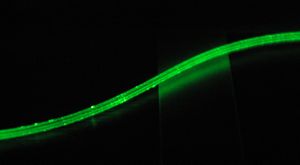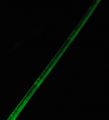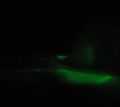Laser Images
Used Fibers
Light Loss Along Length
I took the segments of wave guide that I had examined under microscope and exposed them to a green laser pointer in a dark room. The laser illuminated the wave guide and revealed the effects of surface damage. Areas with fissures, dust, or residue sparkled under the green light. This indicates significant light loss. Understanding light loss is key to the success of the tagger microscope.
Surface Imperfections
Details of the damage are visible in these pictures.
Figure 2: In the upper right-hand third of the image are two parallel bands outlining a section of wave guide that seems brighter. This corresponds to the glue residue from the sticky labeling system. Other damage can also be seen.
Figure 3: Nicks, gouges, and residues coat the length of the fiber, causing light loss everywhere.
New Fibers
Clarity
Freshly cut light guide demonstrates remarkable clarity and minimal light loss. These images illustrate the smoothness of an undamaged surface.
Damage from Clamp
The pictures below all reveal a band of damage near the clamped end of the spooled light guide. The damage goes all the way around the fiber and is only found at this point. I used extreme care when cutting the fiber and transporting it, and I do not believe these marks are from me. The implication of these images is important: if a weak foam-lined clamp (chip-clip style) can cause this damage, then one must wonder about other potential mishandling. I have observed hook-and-loop ties used to store fiber bundles, fibers laid across tables, fibers laid over sandpaper (quickly moved when pointed out), and fibers rubbing against other fibers. all of these scenarios are equally or more abrasive than the chip clip. I hypothesize that the materials coming into direct contact with the fibers are leaving the most damage, but that many, if not all, procedures for manipulating fibers are leaving marks. Pictures of the chip-clip and the hook-and-loop fasteners to come.
In Figure 7, I shined a laser through the new light guide and used a paper bowl to block ambient light from the laser. To the left of the bowl, one sees bright spots on an otherwise dimly lit fiber. This corresponds to the position of the clamp.
Examining Figure 8 reveals several marks along the right half of the fiber. The leftmost striation is the most well-defined, and beyond that the fiber does not spill light. I hypothesize that the clip may have been re-positioned, leaving other scratches, but the leftmost band was the farthest down the fiber that the clip was placed. Some of the poorly defined light loss from the right might simply be due to the position of the laser.
Figure 9 offers an alternate view with less ambient light.
It should be noted that the amount of light in the images varied because the laser intensity varied greatly. It would gradually get dimmer with time, until I removed the batteries and then put them back in. Interrupting contact with the batteries made the laser bright again.
Other Surface Imperfections
The photos included below were taken after handling the segment for a few hours.
After taking many pictures, I started to notice more bright spots along the fibers. While I had taken care not to bang or scratch the fibers, I could not prevent the accumulation of dust. It is even possible that, despite my gentle and gloved handling, the fibers sustained surface damage. No events occurred that seemed harmful to me at the time, but the light loss is indicative of the fibers' general fragility.
In particular, Figure 11 reveals specks of light loss along the edge. In this case, I believe I observed cloth fibers adhering due to static. However, I assume that the edges of the fibers are also the most prone to damage because they have the least amount of material.










